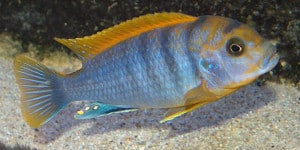
Common name: Red Top Hongi, Hongi, Red Top Kimpuma
Scientific name: Labidochromis Hongi
Average Adult Fish Size: 14cm / 5 Inches
Place of Origin: Lake Malawi
Typical Tank setup: Rocky Malawi tank
Recommended Minimum Aquarium Capacity: 160 Litres
Compatibility: Combine with other Malawi mbuna species
Temperature: 23-28 Deg C / 73-82 Deg F
Water chemistry: pH 7.6-8.6
Feeding: Herbivore – feed african cichlid flakes or pellets specifically for malawi cichlids. Suppliment diet with fresh green vegetables such peas, spinach, romaine lettuce or zucchini
Sexing: Males are larger and more colourful
Breeding: These fish are very easy to breed with the male enticing the female into a spawning crevice or cave, where they repeatedly circle each other until all the eggs are fertilised. Adult males are larger then females by approximately an inch. They are a maternal mouth brooding species. Due to their aggression it is recommend that they are kept in a trio (ratio 1 male to 2 females). The more females per male kept, the more any aggression will be spread. Holding females can be territorial when left in the aquarium, and will nip at any inquisitive fish that makes them feel threatened. Females brood between 18-28 days on average. The minimum recommended tank length for this undescribed species is 4 feet due in part to the males’ aggressive and territorial nature. In fact a 6 foot tank would be preferable.
Additional Information: At this point in time this species is not yet described; therefore it is given the name of its location “Hongi”, which is taken from its name sake Hongi Island. Synonymous names include “Red Top Kimpuma”, “Hongi – Red Top”, and “Hongi Super Red Top”. Labidochromis sp. “Hongi” naturally occurs on the east coast of Lake Malawi in the Tanzanian zone. The population has been sited as far North as Liuli and as far South as Undu Reef. The populations found at Hongi and Lundo Islands being the most attractive. Males are observed to be territorial. The feeding habits of this fish suggest it is a herbivore. The coloration of this fish differs depending on its mood. Dorsal fins also range in colour from yellow to orange. The colors of the dominant male can be quite exquisite, including orange blaze and creamy lilac coloring. Dark vertical barring extends along the sides of the fish from the base of the dorsal fin to the above the upper lip and can completely disappear depending on mood. The dominant males develop egg spots on anal fin and partial egg spots on the dorsal fin. Subdominant males will normally display a drab brownish purple coloration with some orange or yellow highlights. Females will normally show a submissive brownish purple colour, although they too can color shift to a marvellous pale lilac, showing off their darkened bars. Ventral fins in males are predominantly yellow with a dark stripe running from the body to the tip, females have black fins bordered on the front edge in white. Juveniles generally show similar colors to the subdominant males and females.

Related Posts
Croaking Gourami – Trichopsis vittatus
Paradise Fish – Macropodus opercularis
Schubert’s Barb – Barbus Semifasciolatus